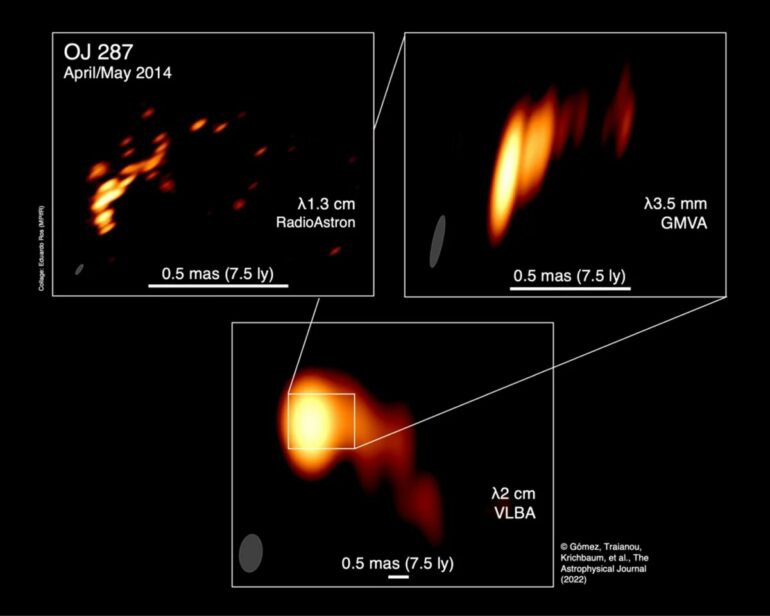An international team, including several researchers from the Max Planck Institute for Radio Astronomy in Bonn, has mapped the active galaxy OJ 287 with an angular resolution of 12 microarcseconds in the radio range. This is currently the highest resolution that can be achieved with astronomical observations. This was made possible by the technique of interferometry with very long baselines. The signals from twelve radio telescopes—one on board the Russian Spektr-R satellite—were combined. The resulting virtual telescope had a diameter of 193,000 kilometers.
The galaxy OJ 287 is located five billion light years from Earth in the direction of the constellation Cancer. It belongs to the class of so-called blazars—galaxies with a supermassive black hole at their center. Apparently, there are even two black holes hidden in the heart of galaxy OJ 287. In the immediate vicinity of these gravity traps, so-called jets—jets of gas—emerge in two opposite directions. These emit radiation that varies in strength.
The interferometric images at four different wavelengths show several emission nodes in the curved jet of OJ 287. In addition, the curvature of the jet increases with increasing angular resolution and in the direction of the jet origin. This supports the hypothesis of a “preceding” jet influenced by the two supermassive black holes at the center of the galaxy.
The analysis of the polarization properties of the radio radiation also shows a predominantly toroidal, quasi donut-shaped magnetic field. From this, the researchers conclude that the innermost radio-emitting region is traversed by a helical magnetic field—in agreement with models for the formation of the jet.
The spectral properties of the radio radiation suggest that the jet plasma consists of electrons and positrons whose kinetic energy is approximately in equilibrium with the energy of the magnetic field. Repeated “injections” of more energetic particles into the jet plasma disturb this equilibrium and cause some parts of the inner jet to flare.
The galaxy OJ 287 is one of the best candidates for two super-massive black holes rotating around each other in our cosmic neighborhood. Presumably, the secondary black hole in this system is in a very tight elliptical orbit and passes through the accretion disk of the primary black hole twice every twelve years. This produces, among other things, strong bursts of radiation (flares).
“One of the most important questions related to the evolution of supermassive black holes is how the pair can eventually merge,” says Andrei Lobanov of the Max Planck Institute for Radio Astronomy. Once the two mass monsters have completely displaced the stars and gas around them, the theory says the distance between the black holes should stop shrinking.
“At this point, gravitational radiation comes into play and causes the two black holes to get closer and closer until they eventually merge,” Lobanov said. In the case of OJ 287, the partners in the suspected binary system are so close that it should emit gravitational waves, which should be detectable in the near future.
A significant fraction of the energy released via the matter accumulated by the black holes ends up in the bipolar and highly relativistic plasma jets. “The observed detailed fine structure of the inner jet region is ideally suited to the test the validity of the binary black hole model,” says Thomas Krichbaum. In addition, the Max Planck scientist from Bonn says they will find out whether the observed jet curvature can also be caused by other effects, such as spiral magnetic fields or the rotating space-time near the black holes.
“The results have helped us to extend our knowledge of the morphology of relativistic jets near the central engine, confirm the role of magnetic fields at the base of the jets, and identify and investigate further features for the existence of a binary black hole deep in the heart of OJ 287,” says Efthalia Traianou, who did her Ph.D. at the Max Planck Institute for Radio Astronomy.
More information:
José L. Gómez et al, Probing the Innermost Regions of AGN Jets and Their Magnetic Fields with RadioAstron. V. Space and Ground Millimeter-VLBI Imaging of OJ 287, The Astrophysical Journal (2022). DOI: 10.3847/1538-4357/ac3bcc
Provided by
Max Planck Society
Citation:
Highest resolution view of the heart of a blazar achieved (2022, January 28)



